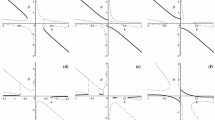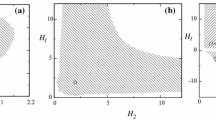Abstract
We consider a particular example of dynamical compactification of an anisotropic \(7+1\) dimensional Universe in Einstein–Gauss–Bonnet gravity. Starting from rather general totally anisotropic initial conditions a Universe in question evolves towards a product of two isotropic subspaces. The first subspace expands isotropically, the second represents an “inner” isotropic subspace with stabilized size. The dynamical evolution does not require fine-tuning of initial conditions, though it is possible for a particular range of coupling constants. The corresponding condition have been found analytically and have been confirmed using numerical integration of equations of motion.


Similar content being viewed by others
Notes
The term “geometric frustration” is used in statistical mechanics to describe a situation where it is not possible to reach a state of minimal interaction energy due to a nontrivial topology of the lattice on which the Hamiltonian is defined.
For definition of constant-volume exponential solutions see [26].
References
Sotiriou, T., Faraoni, V.: f(R) theories of gravity. Rev. Mod. Phys. 82, 451–497 (2010)
Horava, P.: Membranes at quantum criticality. JHEP 0903, 020 (2009)
Horava, P.: Quantum gravity at a Lifshitz point. Phys. Rev. D 79, 084008 (2009)
Horava, P.: Spectral dimension of the universe in quantum gravity at a Lifshitz point. Phys. Rev. Lett. 102, 161301 (2009)
Müller, D., Ricciardone, A., Starobinsky, A., Toporensky, A.: Anisotropic cosmological solutions in \(R+R^2\) gravity. Eur. Phys. J. C 78, 311 (2018)
Lovelock, D.: The Einstein tensor and its generalizations. J. Math. Phys. 12(3), 498–501 (1971)
Zumino, B.: Gravity theories in more than four dimensions. Phys. Rep. 137, 109–114 (1986)
Canfora, F., Giacomini, A., Troncoso, R., Willison, S.: General relativity with small cosmological constant from spontaneous compactification of Lovelock theory in vacuum. Phys. Rev. D 80, 044029 (2009)
Chirkov, D., Giacomini, A., Toporensky, A.: Dynamic compactification with stabilized extra dimensions in cubic Lovelock gravity. Gen. Relativ. Gravit. 50(8), 98 (2018)
Garraffo, C., Giribet, G.: The Lovelock black holes. Mod. Phys. Lett. A 23, 1801 (2008)
Deruelle, N., Fariña-Busto, L.: Lovelock gravitational field equations in cosmology. Phys. Rev. D 41, 3696 (1990)
Demaret, J., Caprasse, H., Moussiaux, A., Tombal, P., Papadopoulos, D.: Ten-dimensional Lovelock-type space-times. Phys. Rev. D 41, 1163 (1990)
Müller-Hoissen, F.: Dimensionally Continued Euler forms: Kaluza–Klein cosmology and dimensional reduction. Class. Quantum Grav. 3, 665 (1986)
Marugan, G.A.Mena : Dynamically generated four-dimensional models in Lovelock cosmology. Phys. Rev. D 46, 4340 (1992)
Boulware, D., Deser, S.: String generated gravity models. Phys. Rev. Lett. 55, 2656 (1985)
Canfora, F., Giacomini, A., Pavluchenko, S.A.: Dynamical compactification in Einstein–Gauss–Bonnet gravity from geometric frustration. Phys. Rev. D 88(6), 064044 (2013)
Canfora, F., Giacomini, A., Pavluchenko, S.A.: Cosmological dynamics in higher-dimensional Einstein–Gauss–Bonnet gravity. Gen. Rel. Grav. 46(10), 1805 (2014)
Yearsley, J., Barrow, J.D.: Cosmological models of dimensional segregation. Class. Quantum Grav. 13, 2693 (1996)
Popov, A.A., Rubin, S.G.: Evolution of sub-spaces at high and low energies. arXiv:1907.05759
Canfora, F., Giacomini, A., Pavluchenko, S., Toporensky, A.: Friedmann dynamics recovered from compactified Einstein–Gauss–Bonnet cosmology. Grav. Cosmol. 24(1), 28–38 (2018)
Ivashchuk, V.D.: On cosmological-type solutions in multi-dimensional model with Gauss–Bonnet term. Int. J. Geom. Methods Mod. Phys. 7, 797 (2010)
Kirnos, I.V., Makarenko, A.N., Pavluchenko, S.A., Toporensky, A.V.: The nature of singularity in multidimensional anisotropic Gauss–Bonnet cosmology with a perfect fluid. Gen. Relativ. Gravit. 42, 2633 (2010)
Kirnos, I.V., Pavluchenko, S.A., Toporensky, A.V.: New features of a flat (4 + 1)-dimensional cosmological model with a perfect fluid in Gauss–Bonnet gravity. Gravitat. Cosmol. 16, 274 (2010)
Chirkov, D.M., Pavluchenko, S.A., Toporensky, A.V.: Exact exponential solutions in Einstein–Gauss–Bonnet flat anisotropic cosmology. Mod. Phys. Lett. A 29, 1450093 (2014)
Chirkov, D., Pavluchenko, S., Toporensky, A.: Non-constant volume exponential solutions in higher-dimensional Lovelock cosmologies. Gen. Relativ. Gravit. 47, 137 (2015)
Chirkov, D., Pavluchenko, S., Toporensky, A.: Constant volume exponential solutions in Einstein–Gauss–Bonnet flat anisotropic cosmology with a perfect fluid. Gen. Relativ. Gravit. 46, 1799 (2014)
Ivashchuk, V.D.: On stability of exponential cosmological solutions with non-static volume factor in the Einstein–Gauss–Bonnet model. Eur. Phys. J. C 76, 431 (2016). arXiv:1607.01244v2
Ivashchuk, V.D.: On anisotropic Gauss–Bonnet cosmologies in \((n + 1)\) dimensions, governed by an \(n\)-dimensional Finslerian 4-metric. Grav. Cosmol. 16(2), 118–125 (2010). arXiv:0909.5462
Chirkov, D., Toporensky, A.: Splitting into two isotropic subspaces as a result of cosmological evolution in Einstein–Gauss–Bonnet gravity. Grav. Cosmol. 25(3), 243 (2019). arXiv:1812.06759
Pavluchenko, S.A.: Stability analysis of exponential solutions in Lovelock cosmologies. Phys. Rev. D 92, 104017 (2015). arXiv:1507.01871
Ernazarov, K.K., Ivashchuk, V.D., Kobtsev, A.A.: On exponential solutions in the Einstein–Gauss–Bonnet cosmology, stability and variation of G. Grav. Cosmol. 22(3), 245–250 (2016)
Chirkov, D.M., Toporensky, A.V.: On stable exponential cosmological solutions in the EGB model with a \(\Lambda \)-term in dimensions D = 5, 6, 7, 8. Grav. Cosmol. 23(4), 359 (2017). arXiv:1706.08889
Pavluchenko, S., Toporensky, A.: Effects of spatial curvature and anisotropy on the asymptotic regimes in Einstein–Gauss–Bonnet gravity. Eur. Phys. J. C 78, 373 (2018)
Acknowledgements
The work of A. V. T. was supported by RFBR Grant 20-02-00411 and by the Russian Government Program of Competitive Growth of Kazan Federal University. The work of A. G. was supported by FONDECYT Grant No. 1200293.
Author information
Authors and Affiliations
Corresponding author
Additional information
Publisher's Note
Springer Nature remains neutral with regard to jurisdictional claims in published maps and institutional affiliations.
Appendix A: Geometric frustration for low-dimensional cases
Appendix A: Geometric frustration for low-dimensional cases
In this section we prove that compactification and isotropization regimes do not coexist in (\(5+1\)) and (\(6+1\))-dimensional EGB cosmological models. For (\(5+1\))-dimensional model we also find all possible values of \(\xi =\alpha \Lambda \) for which compactified solutions exist; it is much more complicated to find all such \(\xi \) for (\(6+1\))-dimensional model, so in the latter case we restrict ourselves by proving that compactification regime can not coexist with isotropic regime.
1.1 (\(5+1\))-Dimensional model
Asymptotic equations in (\(5+1\))-dimensional EGB cosmological model:
Let \(z=H_0^{2};\;y=b_0^{2}\). Then Eqs. (A9)–(A10) take the form:
Substituting \(z_+\) and \(z_-\) into expression for y (see (A11)) we obtain correspondingly
One can see that real values of \(z_{\pm }\) and \(y_{\pm }\) exist only for \(\xi >-\frac{3}{2}\). Also both z and y must be positive. Table 2 demonstrates values of \(\xi \) for which positive z and y exist. This allows us to conclude that compactification in (\(5+1\)) model is possible iff \(\xi \in \left( -\frac{3}{2};-1\right) \).
Isotropic solutions in (\(5+1\))-dimensional EGB cosmological model are defined as
For \(\xi \in \Bigl [-\frac{5}{6};0\Bigr )\) we have 4 possible solutions:
For \(\xi >0\) we have 2 possible solutions:
Taking into account that isotropic solutions exist for \(\xi \geqslant -\frac{5}{6}\), but asymptotic equations (A1)–(A2) has no real solutions for \(\xi \geqslant -\frac{5}{6}\), we conclude isotropization and compactification regimes do not coexist in (\(5+1\))-dimensional EGB cosmological model.
Note that numerical attempts to find compactification solution in \((5+1)\) dimensions have been unsuccessful [33], and the reason for that is still unknown.
1.2 (\(6+1\))-Dimensional model
Asymptotic equations in (\(6+1\))-dimensional EGB cosmological model:
Let \(z=H_0^{2};\;y=b_0^{2}\). Then equations (A9)–(A10) take the form:
Note that both z and y must be positive. Solving (A11) to z we get
Substitution (A13) into (A12) gives us equation for y:
First, we show that there are no real-valued solutions of the Eqs. (A9)–(A10) for \(\xi >-\frac{3}{2}\). It is easy to check that
I. \(-\frac{3}{2}<\xi<0\Longrightarrow \alpha<0;\;\xi \left( \xi +\frac{3}{2}\right)<0;\;y_+<0,\,y_-<0\), therefore \(F'(y)<0\) for all \(y>0\), so function F(y) decrease monotonically for \(y>0\). Taking into account that \(F(0)=432{\alpha }^{3}<0\) and \(F(y)\xrightarrow [y\rightarrow +\infty ]{}-\infty \) we conclude that function F(y) has no positive roots for \(\xi \in \Bigl (-\frac{3}{2};0\Bigr )\) and, therefore, there does not exist real values of \(b_0\) for \(\xi \in \Bigl (-\frac{3}{2};0\Bigr )\).
II. \(\xi>0\Longrightarrow \alpha>0;\;\xi \left( \xi +\frac{3}{2}\right)>0;\;y_-<0,\,y_+>0\). Function F(y) has minimum at \(y_+>0\); \(F(0)=432{\alpha }^{3}>0,\;F(y)\xrightarrow [y\rightarrow +\infty ]{}+\infty \), so if \(F(y_+)<0\) then F(y) has 2 positive zeros. Substituting \(y_+\) into function F we get
and it is easy to see that it is negative for any \(\xi >0\), \(\alpha >0\).
Once we find y from (A14), we should substitute it to (A13) and find z; since z must be positive, solution of (A14) must obey inequality \(y>12\alpha \).
Since \(F(12\alpha )=1728\alpha ^3\left( \xi +\frac{1}{2}\right) ^2>0\) the point \(y=12\alpha \) can not been located between two roots of the equation \(F(y)=0\). Thus, if \(y_+<12\alpha \) then both roots are smaller than \(12\alpha \).
In order to compare \(y_+\) and \(12\alpha \) we introduce function \(G(\xi )\equiv \frac{y_+(\xi ,\alpha )}{12\alpha }= \frac{5\left( \sqrt{1+\frac{24}{25}\xi \left( \xi +\frac{3}{2}\right) \left( \xi +\frac{5}{2}\right) }-1\right) }{12\xi \left( \xi +\frac{3}{2}\right) }\). It is easy to check that \(G'(\xi )<0\) for \(\xi >0\), so function \(G(\xi )\) decrease monotonically for all positive values \(\xi \). On the other hand \(\lim \limits _{\xi \rightarrow 0}G(\xi )=\frac{1}{2}\). It means that \(G(\xi )<\frac{1}{2}\) for \(\xi >0\) and, therefore, \(y_+<6\alpha \). So, all positive roots of function F(y) are smaller than \(12\alpha \), values of z corresponding to these roots are negative and, therefore, there does not exist real values of \(H_0\) for \(\xi >0\).
Second, we turn to isotropic solutions in (\(6+1\))-dimensional EGB cosmological model:
For \(\xi \in \Bigl [-\frac{5}{8};0\Bigr )\) we have 4 possible solutions:
For \(\xi >0\) we have 2 possible solutions:
So, isotropic solutions exist for \(\xi \geqslant -\frac{5}{8}\). Remember the asymptotic equations (A9)–(A10) has no real solutions for \(\xi \geqslant -\frac{3}{2}\). Consequently, isotropization and compactification regimes do not coexist in (\(6+1\))-dimensional EGB cosmological model.
Compactification regime in \((6+1)\) dimensions have been found numerically [33]. Note, however, that structure of equations prevents solution with zero effective cosmological constant in the bigger subspace since \(H=0\) requires \(b=0\).
Rights and permissions
About this article
Cite this article
Chirkov, D., Giacomini, A. & Toporensky, A. Anisotropic cosmological dynamics in Einstein–Gauss–Bonnet gravity: an example of dynamical compactification in \(7+1\) dimensions. Gen Relativ Gravit 52, 30 (2020). https://doi.org/10.1007/s10714-020-02679-x
Received:
Accepted:
Published:
DOI: https://doi.org/10.1007/s10714-020-02679-x




